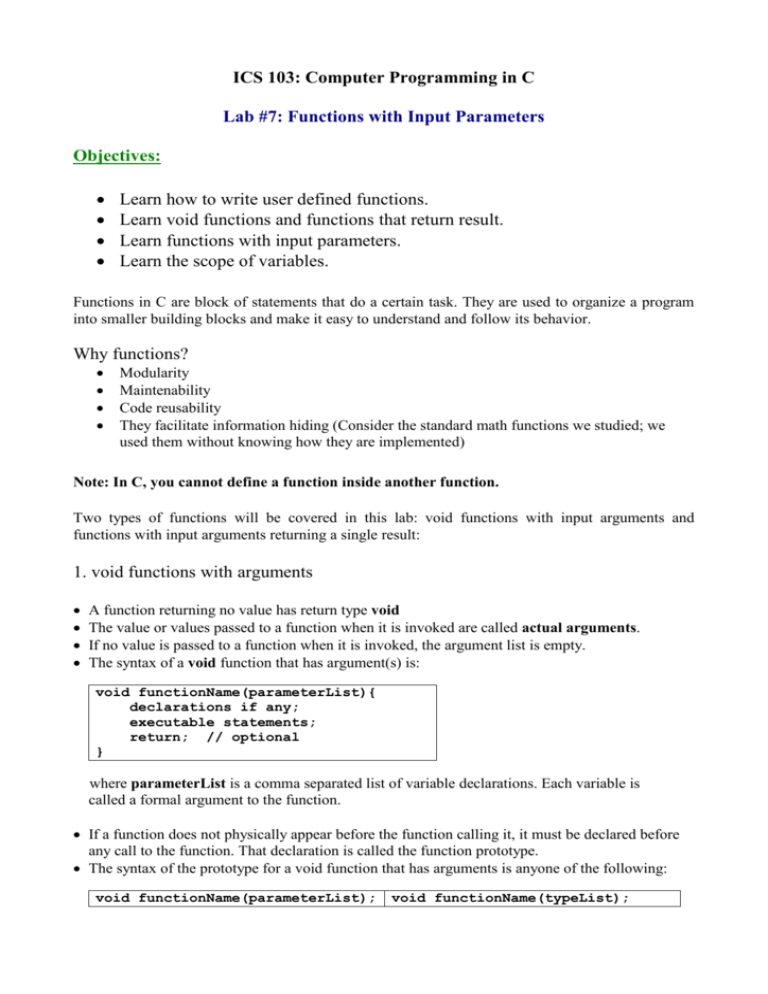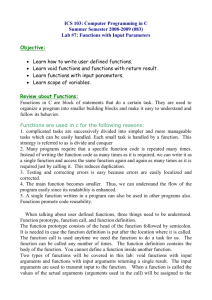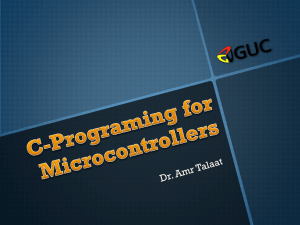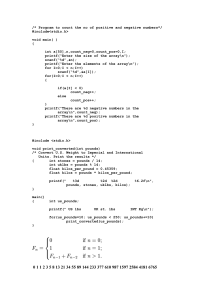Lab07 Functions Part 1
advertisement

ICS 103: Computer Programming in C
Lab #7: Functions with Input Parameters
Objectives:
Learn how to write user defined functions.
Learn void functions and functions that return result.
Learn functions with input parameters.
Learn the scope of variables.
Functions in C are block of statements that do a certain task. They are used to organize a program
into smaller building blocks and make it easy to understand and follow its behavior.
Why functions?
Modularity
Maintenability
Code reusability
They facilitate information hiding (Consider the standard math functions we studied; we
used them without knowing how they are implemented)
Note: In C, you cannot define a function inside another function.
Two types of functions will be covered in this lab: void functions with input arguments and
functions with input arguments returning a single result:
1. void functions with arguments
A function returning no value has return type void
The value or values passed to a function when it is invoked are called actual arguments.
If no value is passed to a function when it is invoked, the argument list is empty.
The syntax of a void function that has argument(s) is:
void functionName(parameterList){
declarations if any;
executable statements;
return; // optional
}
where parameterList is a comma separated list of variable declarations. Each variable is
called a formal argument to the function.
If a function does not physically appear before the function calling it, it must be declared before
any call to the function. That declaration is called the function prototype.
The syntax of the prototype for a void function that has arguments is anyone of the following:
void functionName(parameterList);
void functionName(typeList);
2
The call to a void function with arguments is a statement; it is not part of an expression. Its
syntax is:
functionName(expressionList);
where expressionList is a comma separated list of expressions. Each such expression is
called an actual argument of the function.
Examples:
#include <stdio.h>
#include <stdlib.h>
int main(void){
int length;
char ch;
void drawLine(int, char);
printf("Enter line length: ");
scanf("%d", &length);
fflush(stdin);
printf("\nEnter the drawing character: ");
scanf("%c", &ch);
drawLine(length, ch);
printf("\n");
drawLine(length*2 , ch);
printf("\n");
system("PAUSE");
return 0;
}
void drawLine(int length, char ch){
int k;
for(k = 1; k <= length; k++)
printf("%c", ch);
}
Note:
There must be a one-to-one correspondence between actual arguments and formal
arguments in terms of number and compatible type.
A variable actual argument may or may not have the same name as the corresponding
formal argument (Note that even if the arguments have the same names, they are
different variables).
The scope of a formal argument is its function block.
The scope of a local variable (i.e., a variable declared within a method, is from its point
of declaration to the end of the block; unless if it is re-declared inside a nested block.
3
2. functions with arguments returning a single value
The syntax of a function with arguments and returning a single value is:
returnType functionName(parameterList){
declarations if any;
executable statements;
return expression;
}
Note:
The expression in the return statement must have a type that is compatible with the
function's return type.
It is possible for a function that has one or more selection structures to have more than one
return statement; however only one such statement will be executed.
The call to a function returning a single value is an expression; it can appear anywhere an
expression is allowed.
Examples:
#include <stdio.h>
#include <stdlib.h>
int main(void){
double w, z;
double sumSquares(double, double);
printf("Enter two numbers: ");
scanf("%lf%lf", &w, &z);
printf("\nw = %.2f , z = %.2f\n", w, z);
printf("\nThe sum of squares of 3.0*w + 2.0 and z is %.2f\n",
sumSquares(3.0*w + 2.0, z));
system("PAUSE");
return 0;
}
double sumSquares(double x, double y){
return x * x + y * y;
}
4
#include <stdio.h>
#include <stdlib.h>
int main(void){
int num1, num2, maxValue;
int findMax(int, int);
printf("Enter two integers: ");
scanf("%d%d", &num1, &num2);
maxValue = findMax(num1, num2);
printf("\nThe maximum of %d and %d is %d\n", num1, num2,
maxValue);
system("PAUSE");
return 0;
}
int findMax(int x, int y){
int max;
if(x >= y)
max = x;
else
max = y;
return max;
}
/* Computes the factorial of a number
#include <stdio.h>
int factorial(int n);
*/
int main(void) {
int num, fact;
printf("Enter an integer between 0 and 7: ");
scanf("%d", &num);
if(num < 0) {
printf("Factorial not defined for negative numbers\n");
} else if (num <= 7) {
fact = factorial(num);
printf("The factorial of %d is %d\n", num, fact);
} else
printf("Number out of range: %d\n", num);
system("pause");
return 0;
}
int factorial(int n){
int i, product = 1;
for(i = n; i > 1; --i)
product *= i;
return product;
}
5
Logical functions
In C, logical functions (functions that return true or false) are declared to be of int type: A function that returns 0,
returns false, and a function that returns non-zero value, returns true.
Example:
#include <stdio.h>
#include <stdlib.h>
int main(void){
int num;
int isEven(int);
printf("Enter an integer: ");
scanf("%d", &num);
if(isEven(num))
printf("\n%d is even\n", num);
else
printf("\n%d is odd\n", num);
system("PAUSE");
return 0;
}
int isEven(int b){
return b % 2 == 0;
}
6
Example 1:
//* prints the largest of two integers in a box;
#include<stdio.h>
double bigger(double n1, double n2); // function prototype
void print_rboxed(double rnum); // function prototype
int main(void) {
double number1,number2, max;
printf("Please input two numbers :");
scanf("%lf %lf", &number1, &number2);
max = bigger(number1, number2); // function call
printf("The max of %lf and %lf is\n",number1,number2);
print_rboxed(max) ; // function call
system("pause");
return 0;
}
//returns the largest of two numbers
// function definition
double bigger(double n1, double n2) {
double larger;
if(n1 > n2)
larger = n1;
else
larger = n2;
return larger;
}
/* Displays a real number in a box. */
// function definition
void print_rboxed(double rnum) {
printf("***********\n");
printf("*
*\n");
printf("* %7.2f *\n", rnum);
printf("*
*\n");
printf("***********\n");
}
7
Example 2:
//draws a rectangle using functions
#include <stdio.h>
void draw_solid_line(int size);
void draw_hollow_line(int size);
void draw_rectangle(int len, int wide);
int main(void) {
int length, width;
printf("Enter length and width of rectangle >");
scanf("%d%d", &length, &width);
draw_rectangle(length, width);
system("pause");
return 0;
}
void draw_solid_line(int size) {
int i;
for (i=1; i<=size; i++)
printf("*");
printf("\n");
}
void draw_hollow_line(int size) {
int i;
printf("*");
if (size > 2) {
for (i=1; i<= size-2; i++)
printf(" ");
}
printf("*\n");
}
void draw_rectangle(int len, int wide) {
int i;
draw_solid_line(wide);
if (len > 2) {
for (i=1; i<=len - 2; i++)
draw_hollow_line(wide);
}
draw_solid_line(wide);
}
8
Laboratory Tasks:
1. Modify Example 2 so that the symbol to draw the rectangle,
instead of being ‘*’, should be provided by the user.
2. Write a void function divisors that receives an integer number and
displays its divisors on the screen including 1 and itself. Write the main
function to test your function.
3. Modify the function divisors as an int function that now it returns the
number of divisors excluding 1 and the number itself. Write a main
function to test your function.
The 4 divisors of 32 are 2,4,8 and 16.
4. Write a logical function perfect_Square that receives a positive
integer number and checks if it is a perfect square or not.
Note: perfect square numbers are 4, 9,16,25,36 etc….
9
i.e., a positive integer m is a perfect square if a positive integer n
such that m = n2
Write a main function that makes use of the perfect_Square function to
find and print all perfect squares between m1 and m2 inclusive, where m1
and m2 are end values of a range input by the user. Your program must
display an appropriate message if there is no perfect square between m1
and m2 inclusive.
5. Write a logical function, is_prime, that takes a positive integer
number and determines if the number is prime or not.
Note: A prime number is one that does not have proper factors i.e., it is
a number whose only divisors are 1 and itself.
Write a main function that makes use of the is_prime function to find
and print all the prime numbers from 2 to 100.








